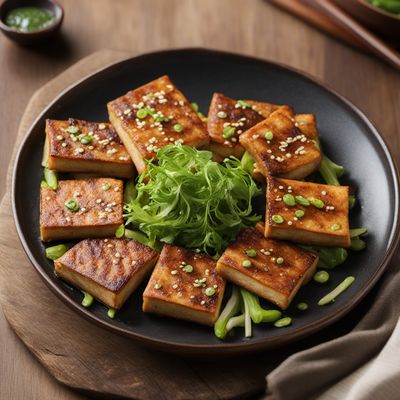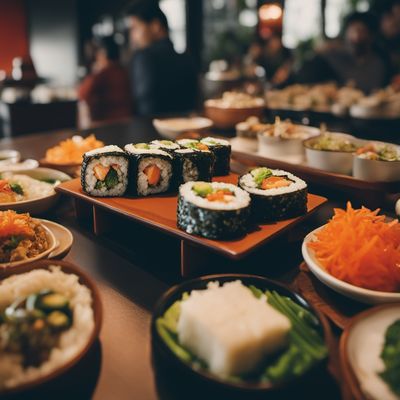
Recipe
Japchae - Korean Glass Noodle Stir-Fry
Savory Harmony: Korean Glass Noodle Stir-Fry with Vibrant Flavors
4.8 out of 5
Japchae is a classic Korean dish that showcases the harmonious blend of flavors and textures. This stir-fry features chewy glass noodles, colorful vegetables, and tender marinated beef, all tossed in a delicious soy-based sauce.
Metadata
Preparation time
25 minutes
Cooking time
15 minutes
Total time
40 minutes
Yields
4 servings
Preparation difficulty
Medium
Suitable for
Gluten-free, Dairy-free, Nut-free, Low-fat, Low-calorie
Allergens
Soy, Sesame
Not suitable for
Vegan, Vegetarian, Paleo, Keto, High-protein
Ingredients
-
200g (7 oz) sweet potato glass noodles 200g (7 oz) sweet potato glass noodles
-
200g (7 oz) beef sirloin, thinly sliced 200g (7 oz) beef sirloin, thinly sliced
-
2 tablespoons soy sauce 2 tablespoons soy sauce
-
2 tablespoons sesame oil 2 tablespoons sesame oil
-
2 cloves garlic, minced 2 cloves garlic, minced
-
1 tablespoon sugar or honey 1 tablespoon sugar or honey
-
1 carrot, julienned 1 carrot, julienned
-
1 red bell pepper, thinly sliced 1 red bell pepper, thinly sliced
-
100g (3.5 oz) spinach 100g (3.5 oz) spinach
-
100g (3.5 oz) shiitake mushrooms, sliced 100g (3.5 oz) shiitake mushrooms, sliced
-
2 green onions, sliced 2 green onions, sliced
-
Salt and pepper to taste Salt and pepper to taste
-
Sesame seeds, for garnish Sesame seeds, for garnish
Nutrition
- Calories (kcal / KJ): 320 kcal / 1340 KJ
- Fat (total, saturated): 10g, 2g
- Carbohydrates (total, sugars): 45g, 6g
- Protein: 15g
- Fiber: 3g
- Salt: 1.5g
Preparation
-
1.Cook the glass noodles according to package instructions. Drain and rinse with cold water to prevent sticking. Set aside.
-
2.In a bowl, combine the beef slices with soy sauce, minced garlic, and sugar/honey. Let it marinate for 15 minutes.
-
3.Heat a tablespoon of sesame oil in a large pan or wok over medium-high heat. Stir-fry the marinated beef until cooked through. Remove from the pan and set aside.
-
4.In the same pan, add another tablespoon of sesame oil. Sauté the carrots, bell pepper, spinach, and mushrooms until tender-crisp. Season with salt and pepper.
-
5.Add the cooked glass noodles and the cooked beef back to the pan. Pour in the remaining soy sauce and sesame oil. Stir-fry everything together until well combined and heated through.
-
6.Remove from heat and garnish with sliced green onions and sesame seeds.
Treat your ingredients with care...
- Glass noodles — Be careful not to overcook the glass noodles as they can become mushy. Follow the package instructions and rinse with cold water after cooking to maintain their chewy texture.
- Beef — For a more tender result, slice the beef against the grain. Marinating the beef helps to infuse it with flavor and tenderize it further.
Tips & Tricks
- To add extra depth of flavor, you can add a splash of rice wine or mirin to the marinade.
- Feel free to customize the vegetable selection based on your preferences or seasonal availability.
- If you prefer a spicier version, add a teaspoon of gochujang (Korean chili paste) to the sauce.
- Leftovers can be enjoyed cold as a refreshing salad the next day.
- Garnish with additional sesame seeds and a drizzle of sesame oil for an extra touch of flavor.
Serving advice
Serve Japchae as a main dish accompanied by a bowl of steamed rice. It can also be served as a side dish or a part of a larger Korean meal. Enjoy it warm or at room temperature.
Presentation advice
Arrange the Japchae on a platter, allowing the vibrant colors of the vegetables to shine through. Sprinkle some sesame seeds on top for an attractive garnish. Serve with a side of steamed rice and kimchi for a complete Korean dining experience.









